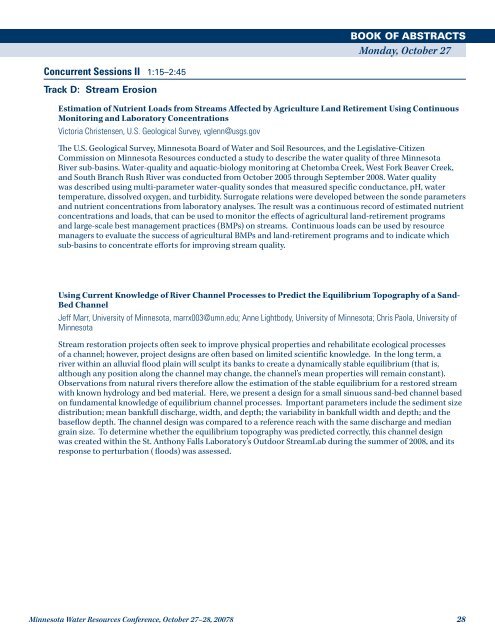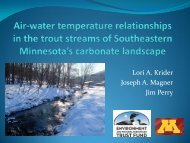Minnesota Water Resources Conference - Water Resources Center ...
Minnesota Water Resources Conference - Water Resources Center ...
Minnesota Water Resources Conference - Water Resources Center ...
Create successful ePaper yourself
Turn your PDF publications into a flip-book with our unique Google optimized e-Paper software.
BOOK OF ABSTRACTS<br />
Tuesday, Monday, October 27 23<br />
Concurrent Sessions II 1:15–2:45<br />
Track D: Stream Erosion<br />
Estimation of Nutrient Loads from Streams Affected by Agriculture Land Retirement Using Continuous<br />
Monitoring and Laboratory Concentrations<br />
Victoria Christensen, U.S. Geological Survey, vglenn@usgs.gov<br />
The U.S. Geological Survey, <strong>Minnesota</strong> Board of <strong>Water</strong> and Soil <strong>Resources</strong>, and the Legislative-Citizen<br />
Commission on <strong>Minnesota</strong> <strong>Resources</strong> conducted a study to describe the water quality of three <strong>Minnesota</strong><br />
River sub-basins. <strong>Water</strong>-quality and aquatic-biology monitoring at Chetomba Creek, West Fork Beaver Creek,<br />
and South Branch Rush River was conducted from October 2005 through September 2008. <strong>Water</strong> quality<br />
was described using multi-parameter water-quality sondes that measured specific conductance, pH, water<br />
temperature, dissolved oxygen, and turbidity. Surrogate relations were developed between the sonde parameters<br />
and nutrient concentrations from laboratory analyses. The result was a continuous record of estimated nutrient<br />
concentrations and loads, that can be used to monitor the effects of agricultural land-retirement programs<br />
and large-scale best management practices (BMPs) on streams. Continuous loads can be used by resource<br />
managers to evaluate the success of agricultural BMPs and land-retirement programs and to indicate which<br />
sub-basins to concentrate efforts for improving stream quality.<br />
Using Current Knowledge of River Channel Processes to Predict the Equilibrium Topography of a Sand-<br />
Bed Channel<br />
Jeff Marr, University of <strong>Minnesota</strong>, marrx003@umn.edu; Anne Lightbody, University of <strong>Minnesota</strong>; Chris Paola, University of<br />
<strong>Minnesota</strong><br />
Stream restoration projects often seek to improve physical properties and rehabilitate ecological processes<br />
of a channel; however, project designs are often based on limited scientific knowledge. In the long term, a<br />
river within an alluvial flood plain will sculpt its banks to create a dynamically stable equilibrium (that is,<br />
although any position along the channel may change, the channel’s mean properties will remain constant).<br />
Observations from natural rivers therefore allow the estimation of the stable equilibrium for a restored stream<br />
with known hydrology and bed material. Here, we present a design for a small sinuous sand-bed channel based<br />
on fundamental knowledge of equilibrium channel processes. Important parameters include the sediment size<br />
distribution; mean bankfull discharge, width, and depth; the variability in bankfull width and depth; and the<br />
baseflow depth. The channel design was compared to a reference reach with the same discharge and median<br />
grain size. To determine whether the equilibrium topography was predicted correctly, this channel design<br />
was created within the St. Anthony Falls Laboratory’s Outdoor StreamLab during the summer of 2008, and its<br />
response to perturbation ( floods) was assessed.<br />
<strong>Minnesota</strong> <strong>Water</strong> <strong>Resources</strong> <strong>Conference</strong>, October 27–28, 20078 28
















